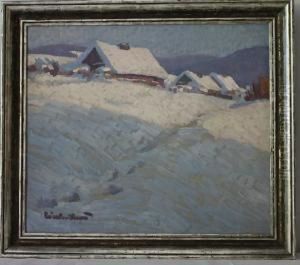Karl Reinecke-Altenau Paintings
Karl Reinecke-Altenau was a German painter, illustrator, and etcher, born on August 17, 1863, in Altenau, Germany. He was the son of the famous composer and music director Carl Reinecke, which exposed him to the cultural milieu of the time from an early age. Despite the musical environment he grew up in, Karl was drawn to the visual arts. His talent became evident during his formative years, prompting him to pursue a career in fine arts.
Reinecke-Altenau studied at the Academy of Fine Arts in Munich, which was known for its focus on realism and historical subjects. His education there was pivotal, as it shaped his technical skills and artistic direction. He was influenced by the naturalist and realist movements, which can be seen in his detailed landscape paintings and etchings that often depicted the German countryside and its inhabitants.
Throughout his career, Reinecke-Altenau exhibited a profound love for the Harz Mountains, a region that frequently appeared in his works. His landscapes are characterized by a meticulous attention to detail and a serene, often idyllic portrayal of nature. He captured the changing seasons, the play of light and shadow, and the rural life of the area with a gentle realism that was appreciated by his contemporaries.
Besides landscapes, Karl Reinecke-Altenau also created illustrations for books, showcasing his versatility as an artist. His illustrations often contained elements of folklore and myth, reflecting a deep interest in the cultural heritage of his homeland.
Reinecke-Altenau's work was well-received during his lifetime, and he participated in numerous exhibitions. His artwork is a testament to the transitional period in German art, bridging the gap between late 19th-century realism and the emerging styles of the early 20th century.
Karl Reinecke-Altenau passed away on May 20, 1942, in Bad Harzburg, Germany. Although he may not be as widely recognized as some of his contemporaries, his contributions to German art during his time were significant, and his works remain a valuable part of the country's artistic heritage, particularly for their portrayal of the German landscape and rural life.
